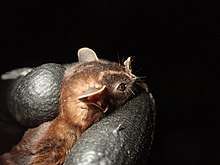Velvety fruit-eating bat
The velvety fruit-eating bat (Enchisthenes hartii), also known as Hart's little fruit bat, is a species of bat in the family Phyllostomidae. It is monotypic within the genus Enchisthenes. It is found in Central America, Mexico, the United States, and northern South America.[1]
| Velvety fruit-eating bat | |
|---|---|
 | |
| In Puntarenas, Costa Rica | |
| Scientific classification | |
| Kingdom: | Animalia |
| Phylum: | Chordata |
| Class: | Mammalia |
| Order: | Chiroptera |
| Family: | Phyllostomidae |
| Genus: | Enchisthenes K. Andersen, 1906 |
| Species: | E. hartii |
| Binomial name | |
| Enchisthenes hartii (Thomas, 1892) | |
 | |
| Synonyms | |
|
Artibeus hartii Thomas, 1892 | |
Taxonomy and etymology
It was described as a new species in 1892 by British zoologist Oldfield Thomas. Thomas initially placed it in the genus Artibeus, with the scientific name Artibeus hartii. The eponym for the species name "hartii" is J. H. Hart, who provided the holotype to Thomas. Hart was the superintendent of the Botanic Gardens in Trinidad, which is the type locality.[2]
The genus Enchisthenes was described in 1908 by Danish mammalogist Knud Andersen. He noted that Enchisthenes was closely related to Artibeus, and designated A. hartii as the type species and the only member of the genus.[3] Though the opinion of the taxonomic validity of Enchisthenes has varied since its description, it has most recently been recognized as a valid monotypic genus.[4]
Description
Its fur is nearly black in color, and its face has a few faint lines that are paler in color. It has a forearm length of 36–41 mm (1.4–1.6 in). Individuals weigh 14–18 g (0.49–0.63 oz). Its dental formula is 2.1.2.32.1.2.3 for a total of 32 teeth.[4]
Range and habitat
Its range includes Central and South America. Countries within its range include Bolivia, Colombia, Costa Rica, Ecuador, El Salvador, Guatemala, Honduras, Mexico, Panama, Peru, Trinidad and Tobago, and Venezuela. There is a single record from the United States state of Arizona.[1]
Conservation
As of 2008, it is evaluated as a least-concern species by the IUCN. It meets the criteria for this designation because it has a wide geographic range; its population is presumably large; and it is unlikely to be experiencing rapid population decline.[1]
References
- Solari, S. (2018). "Enchisthenes hartii". IUCN Red List of Threatened Species. 2018: e.T2130A21996891. doi:10.2305/IUCN.UK.2018-2.RLTS.T2130A21996891.en.
- Thomas, O. (1892). "XLVIII.—Description of a new bat of the genus Artibeus from Trinidad". The Annals and Magazine of Natural History; Zoology, Botany, and Geology. 6. 10 (59): 409.
- Andersen, K. (1908). "A monograph of the chiropteran genera Uroderma, Enchisthenes, and Artibeus". Proceedings of the Zoological Society of London. 78 (2): 221–224.
- Cabrales, J. A. (2014). Ceballos, G. (ed.). Mammals of Mexico. JHU Press. pp. 735–736. ISBN 978-1421408439.
